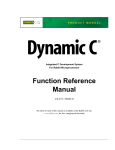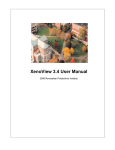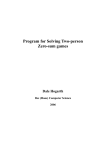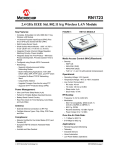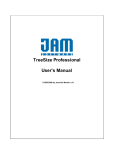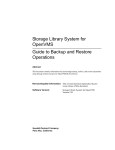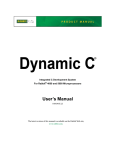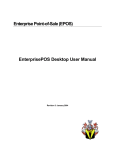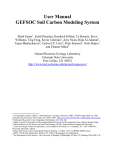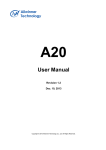Download Embedded Filesystems Library - 0.3
Transcript
EFSL
Embedded Filesystems Library - 0.3
Lennart Yseboodt
Michael De Nil
c 2005
°
1
Contents
1 Document Outdated!
3
2 Preface
2.1 Project aims . . . . . . . . . . . . . . . . . . . . . . . . . . . . .
2.2 Project status . . . . . . . . . . . . . . . . . . . . . . . . . . . . .
2.3 License . . . . . . . . . . . . . . . . . . . . . . . . . . . . . . . . .
4
4
4
4
3 Getting started
3.1 On Linux (file) (0.2) . . . . .
3.1.1 Download & Compile
3.1.2 Example . . . . . . . .
3.1.3 Testing . . . . . . . .
3.2 On AVR (SD-Card) (0.3) . .
3.2.1 Hardware . . . . . . .
3.2.2 Download & Compile
3.2.3 Example . . . . . . . .
3.2.4 Testing . . . . . . . .
3.3 On DSP (SD-Card) (0.2) . .
3.3.1 Hardware . . . . . . .
3.3.2 McBSP configuration
.
.
.
.
.
.
.
.
.
.
.
.
.
.
.
.
.
.
.
.
.
.
.
.
.
.
.
.
.
.
.
.
.
.
.
.
.
.
.
.
.
.
.
.
.
.
.
.
.
.
.
.
.
.
.
.
.
.
.
.
.
.
.
.
.
.
.
.
.
.
.
.
.
.
.
.
.
.
.
.
.
.
.
.
.
.
.
.
.
.
.
.
.
.
.
.
.
.
.
.
.
.
.
.
.
.
.
.
.
.
.
.
.
.
.
.
.
.
.
.
.
.
.
.
.
.
.
.
.
.
.
.
.
.
.
.
.
.
.
.
.
.
.
.
.
.
.
.
.
.
.
.
.
.
.
.
.
.
.
.
.
.
.
.
.
.
.
.
.
.
.
.
.
.
.
.
.
.
.
.
.
.
.
.
.
.
.
.
.
.
.
.
.
.
.
.
.
.
.
.
.
.
.
.
.
.
.
.
.
.
.
.
.
.
.
.
.
.
.
.
.
.
.
.
.
.
.
.
.
.
.
.
.
.
.
.
.
.
.
.
5
5
5
5
7
8
8
9
10
11
13
13
14
4 Configuring EFSL (0.2)
4.1 Hardware target . . .
4.2 Memory configuration
4.3 Cache configuration .
4.4 Pre-allocation . . . . .
4.5 Endianness . . . . . .
4.6 Date and time . . . .
4.7 Errors . . . . . . . . .
4.8 Debug . . . . . . . . .
.
.
.
.
.
.
.
.
.
.
.
.
.
.
.
.
.
.
.
.
.
.
.
.
.
.
.
.
.
.
.
.
.
.
.
.
.
.
.
.
.
.
.
.
.
.
.
.
.
.
.
.
.
.
.
.
.
.
.
.
.
.
.
.
.
.
.
.
.
.
.
.
.
.
.
.
.
.
.
.
.
.
.
.
.
.
.
.
.
.
.
.
.
.
.
.
.
.
.
.
.
.
.
.
.
.
.
.
.
.
.
.
.
.
.
.
.
.
.
.
.
.
.
.
.
.
.
.
.
.
.
.
.
.
.
.
.
.
.
.
.
.
.
.
.
.
.
.
.
.
.
.
.
.
.
.
.
.
.
.
.
.
.
.
.
.
.
.
.
.
.
.
.
.
.
.
.
.
.
.
.
.
.
.
15
15
15
16
17
18
18
18
18
5 EFSL Functions
5.1 Date and time support
5.2 efs init (0.2) . . . . . .
5.3 file fopen (0.2) . . . .
5.4 file fclose (0.2) . . . .
5.5 file read (0.2) . . . . .
5.6 file write (0.2) . . . . .
5.7 mkdir (0.2) . . . . . .
5.8 ls openDir (0.2) . . . .
5.9 ls getNext (0.2) . . . .
(0.2)
. . .
. . .
. . .
. . .
. . .
. . .
. . .
. . .
.
.
.
.
.
.
.
.
.
.
.
.
.
.
.
.
.
.
.
.
.
.
.
.
.
.
.
.
.
.
.
.
.
.
.
.
.
.
.
.
.
.
.
.
.
.
.
.
.
.
.
.
.
.
.
.
.
.
.
.
.
.
.
.
.
.
.
.
.
.
.
.
.
.
.
.
.
.
.
.
.
.
.
.
.
.
.
.
.
.
.
.
.
.
.
.
.
.
.
.
.
.
.
.
.
.
.
.
.
.
.
.
.
.
.
.
.
.
.
.
.
.
.
.
.
.
.
.
.
.
.
.
.
.
.
.
.
.
.
.
.
.
.
.
.
.
.
.
.
.
.
.
.
.
.
.
.
.
.
.
.
.
.
.
.
.
.
.
.
.
.
.
.
.
.
.
.
.
.
.
.
.
.
.
.
.
.
.
.
19
19
20
21
23
25
27
29
31
32
. . . .
. . . .
Linux
AVR .
DSP .
.
.
.
.
.
.
.
.
.
.
.
.
.
.
.
.
.
.
.
.
.
.
.
.
.
.
.
.
.
.
.
.
.
.
.
.
.
.
.
.
.
.
.
.
.
.
.
.
.
.
.
.
.
.
.
.
.
.
.
.
.
.
.
.
.
.
.
.
.
.
.
.
.
.
.
.
.
.
.
.
.
.
.
.
.
.
.
.
.
.
.
.
.
.
.
.
.
.
.
.
.
.
.
.
.
34
34
34
34
35
35
6 Developer notes
6.1 Integer types (0.2) .
6.2 Debugging (0.2) . . .
6.2.1 Debugging on
6.2.2 Debugging on
6.2.3 Debugging on
.
.
.
.
.
.
.
.
2
6.3
6.4
6.5
Adding support for a new endpoint
6.3.1 hwInterface . . . . . . . . .
6.3.2 if initInterface . . . . . . .
6.3.3 if readBuf . . . . . . . . . .
6.3.4 if writeBuf . . . . . . . . .
I/O Manager (0.2) . . . . . . . . .
6.4.1 General operation . . . . .
6.4.2 Cache decisions . . . . . . .
6.4.3 Functions . . . . . . . . . .
C library for EFSL (0.2) . . . . . .
(0.2)
. . .
. . .
. . .
. . .
. . .
. . .
. . .
. . .
. . .
.
.
.
.
.
.
.
.
.
.
.
.
.
.
.
.
.
.
.
.
.
.
.
.
.
.
.
.
.
.
.
.
.
.
.
.
.
.
.
.
.
.
.
.
.
.
.
.
.
.
.
.
.
.
.
.
.
.
.
.
.
.
.
.
.
.
.
.
.
.
.
.
.
.
.
.
.
.
.
.
.
.
.
.
.
.
.
.
.
.
.
.
.
.
.
.
.
.
.
.
.
.
.
.
.
.
.
.
.
.
.
.
.
.
.
.
.
.
.
.
.
.
.
.
.
.
.
.
.
.
.
.
.
.
.
.
.
.
.
.
35
37
37
38
38
38
39
39
40
43
7 Legal notes
44
7.1 GNU Lesser General Public License . . . . . . . . . . . . . . . . 44
3
1
Document Outdated!
This document is outdated and is
in the progress of being renewed.
If you are just starting with Efsl,
we recommend you to start with
the stable 0.2-branch. This version
is currently not really usable, and
is intended for people working on
the code.
4
2
2.1
Preface
Project aims
The EFSL project aims to create a library for filesystems, to be used on various
embedded systems. Currently we support the Microsoft FAT filesystem family.
It is our intention to create pure ANSI C code that compiles on anything that
bears the name ’C compiler’. We don’t make assumptions about endianness or
how the memory alignment is arranged on your architecture.
Adding code for your specific hardware is straightforward, just add code that
fetches or writes a 512 byte sector, and the library will do the rest. Existing code
can be used, writing your own code is only required when you have hardware
for which no target exists.
2.2
Project status
Efsl currently supports FAT12, FAT16 and FAT32. Read and write has been
tested and is stable. Efsl runs on PC (GNU/Linux, development environment),
TMS C6000 DSP’s from Texas instruments, and ATMega’s from Atmel. You
can use this code with as little as 1 kilobyte RAM, however if you have more
at your disposal, an infinite amount can be used as cache memory. The more
memory you commit, the better the performance will be.
2.3
License
This project is released under the Lesser General Public license, which means
that you may use the library and it’s sourcecode for any purpose you want, that
you may link with it and use it commercially, but that ANY change to the code
must be released under the same license. We would appreciate if you would send
us a patch when you add support for new hardware, but this is not obligatory,
since it falls under linking as far as the LGPL is concerned.
5
3
Getting started
3.1
On Linux (file) (0.2)
Debugging efsl on embedded devices is a rather hard job, because you can’t just
printf debug strings or watch memory maps easily. Because of that, core development has been performed under the Linux operating system. Under Linux,
efsl can be compiled as library and used as a userspace filesystem handler. On
Unix- style operating system (like Linux), all devices (usb stick, disc, . . . ) can
be seen as a file, and as such been opened by efsl.
In the following section, we will explain how to get started using efsl as userspace
filesystem handler. However, please note that the main focus for efsl is to support embedded systems, which usually don’t even have 1% of the memory you
have on a PC. Accessing files on a FAT-filesystem with efsl will be much slower
than when accessing these files with the Linux FAT kernel modules.
3.1.1
Download & Compile
Let’s get started:
1. Get the latest release of efsl on http://www.sf.net/projects/efsl/ and put
it in your homedir
2. Unpack the library (tar xvfj efsl-version.tar.bz2)
3. Get inside the directory (cd ∼/efsl)
4. Create a symlink from Makefile-LINUX to Makefile (ln -s Makefile-LINUX
Makefile)
5. Copy conf/config-sample-linux.h to conf/config.h (cp conf/config-samplelinux.h conf/config.h)
6. Compile the library (make lib)
7. Find the compiled filesystem library (libefsl.a) in the current directory
If you got any errors with the steps above, please check that that you have the
following packages installed: tar, gcc, libgcc, binutils & make.
3.1.2
Example
Since efsl itself is only a library, it’s not supposed to do anything out of the box,
than just compile. To get started, we’ll show here a small example program
that opens a file on a disc/usb-stick/floppy that contains a FAT-filesystem and
prints it’s content to stdout.
First, create a new directory in which you put the compiled efsl-library ( libefsl.a
) and create a new file called linuxtest.c containing:
6
1
2
3
4
5
6
7
8
9
10
11
12
13
14
15
16
17
18
19
20
21
22
23
24
25
26
27
#i n c l u d e <s t d i o . h>
#i n c l u d e < e f s . h>
int main ( void )
{
EmbeddedFileSystem e f s ;
EmbeddedFile f i l e ;
unsigned short i , e ;
char buf [ 5 1 2 ] ;
i f ( e f s i n i t (& e f s , ”/ dev / sda ” ) ! = 0 ) {
p r i n t f ( ” Could not open f i l e s y s t e m . \ n” ) ;
return ( −1);
}
i f ( f i l e f o p e n (& f i l e ,& e f s . myFs , ” group ” , ’ r ’ ) ! = 0 ) {
p r i n t f ( ” Could not open f i l e . \ n” ) ;
return ( −2);
}
while ( e=f i l e r e a d (& f i l e , 5 1 2 , buf ) ) {
fo r ( i =0; i <e ; i ++)
p r i n t f ( ”\%c ” , buf [ i ] ) ;
}
return ( 0 ) ;
}
Some extra information on the code above:
• Line 1-2: The header files for stdio (used for printf) and efsl are included.
When using the basic efsl functions, efs.h is the only header file of the
efsl library that needs to be included.
• Line 6: The object efs is created, this object will contain information
about the hardware layer, the partition table and the disc.
• Line 7: The object file is created, this object will contain information
about the file that we will open on the efs-object.
• Line 9: A buffer of 512 bytes is allocated. This buffer will be filled by
fread with data.
• Line 11-14: Call of efs init , which will initialize the efs-object. To this
function we pass:
1. A pointer to the efs-object.
2. A pointer to the file that contains the partition table / file system
(in this example, we select a device as file).
7
If this function returns 0, it means that a valid fat partition is found on
the device given. If no valid fat-filesystem is found, or the file does not
exist, the function returns a negative value. In this example we then print
an error message and quit.
• Line 16-19: Call of file fopen() , which will initialize the file-object.
To this function we pass:
1. A pointer to the file-object.
2. A pointer to the filesystem-object.
3. A pointer to the filename.
4. A char containing the the mode (read, write, append).
If this function returns 0, it means the file has successfully been opened for
reading / writing / appending. If the file could not be opened, a negative
value is returned.
• Line 21-24: Call of file read() , which will read a given value of bytes
(in this example 512) from a file and put it’s content into the buffer passed
(in this example called buf). This function returns the amount of bytes
read, so the while-loop will be executed as long as there are bytes left in
the file. The code inside the while-loop will print all characters in the
buffer.
3.1.3
Testing
So now let’s test the program:
1. Compile the program (gcc -I/home/user/efsl/inc/ -I/home/user/efsl/conf
-o linuxtest linuxtest.c -L./ -lefsl).
2. Insert a usb-disc, floppy, mp3-stick, . . . with a valid fat-filesystem on it.
3. Mount the device, copy the file /etc/group on it’s root dir & umount it.
4. Check that you have permission to access the device (chown username
/dev/sda*)
5. Run the program (./linuxtest)
8
3.2
On AVR (SD-Card) (0.3)
This section describes how to implement Efsl on a AVR µC connected to an SDCard (SPI). For getting efsl to compile, the avr-gcc compiler and avr-libc library
are required. On Windows you should install WinAVR (http://winavr.sourceforge.net/),
on Linux you can install the packages separately (see http://www.nongnu.org/avrlibc/user-manual/install tools.html for a nice howto).
3.2.1
Hardware
First, you need set up a prototype in which you connect the CD, CMD, DAT0
& CLK lines from the SD-Card to /CS, MOSI, MISO & SCK from the Atmega.
9
Connect the following lines on the SDcard:
• Pin 9 (DAT2) - NC
(or pull-up to 3.3V)
• Pin 1 (CD) - Any pin on the Atmega128
• Pin 2 (CMD) - MOSI
(pin 12 on the Atmega128)
• Pin 3 (Vss) - GND
• Pin 4 (Vdd) - +3.3V
• Pin 5 (CLK) - SCK
(pin 11 on the Atmega128)
• Pin 6 (Vss) - GND
• Pin 7 (DAT0) - MISO
(pin 12 on the Atmega128)
Remark: this schematic includes
pull-up’s to 3.3V, which can be left off.
• Pin 8 (DAT1) - NC
(or pull-up to 3.3V)
Remark 1: Make sure that your µC is running on 3,3V, so you don’t damage
your SD-Card.
Remark 2: CD is currently static set to PB0, but will become variable in future
releases.
3.2.2
Download & Compile
Let’s get started:
1. Get the latest release of efsl on http://www.sf.net/projects/efsl/
2. Unpack the library (on Windows, you can use WinACE or WinRAR)
3. Copy in directory conf the file config-avr.h to config.h
4. Copy in directory conf the file config-avr.makefile to config.makefile
5. Compile the library ( make avr )
Now you should have the following files in a directory called lib:
• libefsl-base.a
• libefsl-fs-vfat.a
• libefsl-prot-sdspi.a
• libefsl-hwd-atmega spi.a
10
3.2.3
Example
Since Efsl itself is only a library, it’s not supposed to do anything out of the
box, than just compile. To get started, we’ll show here a small example program
that opens an existing file and writes the content to a new file.
First, create a new directory in which you put the compiled efsl-library ( libefsl.a
) and create a new file called avrtest.c containing:
1
2
3
4
5
6
7
8
9
10
11
12
13
14
15
16
17
18
19
20
21
22
23
24
25
26
27
28
29
30
31
32
33
34
35
36
37
38
39
40
41
#i n c l u d e < e f s . h>
#i n c l u d e <sd . h>
#i n c l u d e <a t m e g a s p i . h>
void hang ( void ) ;
void main ( void )
{
efsl storage conf storage conf ;
efsl fs conf fs conf ;
efsl
efsl
File
File
s t o r a g e storage ;
fs fs ;
file r ;
file w ;
atmegaSpiInterface s p i i n t e r f a c e ;
SdSpiProtocol sd protocol ;
char buf [ 5 1 2 ] ;
unsigned short e ;
/∗ I n i t ∗/
s p i i n t e r f a c e . p i n S e l e c t =0x01 ;
s d p r o t o c o l . s p i H w I n t e r f a c e=&s p i i n t e r f a c e ;
s d p r o t o c o l . s p i H w I n i t =(void ∗ ) a t m e g a s p i i n i t ;
s d p r o t o c o l . spi SendBy te =(void ∗ ) a t m e g a s p i s e n d ;
storage
storage
storage
storage
storage
storage
conf
conf
conf
conf
conf
conf
. hwObject=&s d p r o t o c o l ;
. i f i n i t f p t r =(void ∗ ) s d I n i t ;
. i f r e a d f p t r =(void ∗ ) s d r e a d S e c t o r ;
. i f w r i t e f p t r =(void ∗ ) s d w r i t e S e c t o r ;
. i f i o c t l f p t r =(void ∗ ) s d i o c t l ;
. ioman bufmem =0;
f s c o n f . n o p a r t i t i o n s =0;
f s c o n f . s t o r a g e=&s t o r a g e ;
i f ( e f s l i n i t S t o r a g e (& s t o r a g e ,& s t o r a g e c o n f ) ) {
hang ( ) ;
11
}
42
43
44
45
46
47
48
49
50
51
52
53
54
55
56
57
58
59
60
61
62
63
64
65
66
67
68
69
70
71
72
73
74
75
76
i f ( e f s l i n i t F s (& f s ,& f s c o n f ) ) {
hang ( ) ;
}
i f ( f i l e f o p e n (& f i l e r ,& f s . f i l e s y s t e m , ” o r i g . t x t ” , ’ r ’ ) ! = 0 ) {
hang ( ) ;
}
i f ( f i l e f o p e n (& f i l e w ,& f s . f i l e s y s t e m , ” copy . t x t ” , ’w ’ ) ! = 0 ) {
hang ( ) ;
}
i f ( f i l e f o p e n (& f i l e r ,& e f s . myFs , ” o r i g . t x t ” , ’ r ’ ) ! = 0 ) {
hang ( ) ;
}
while ( ( e=f i l e r e a d (& f i l e r , 5 1 2 , buf ) ) ) {
f i l e w r i t e (& f i l e w , e , buf ) ;
}
f i l e f c l o s e (& f i l e r ) ;
f i l e f c l o s e (& f i l e w ) ;
fs umount (& f s . f i l e s y s t e m ) ;
hang ( ) ;
}
void hang ( void )
{
while ( ( 1 ) )
NOP ( ) ;
}
Some extra information on the code above: TODO
3.2.4
Testing
So now let’s test the program:
1. Compile the program:
• On Linux (with avr-gcc): avr-gcc -I/home/user/src/base/include I/home/user/src/include -I/home/user/src/fs/vfat/include -I/home/user/src/hwdrivers/atmega s
-I/home/user/src/protocols/sdcard spi/include -I/home/user/conf ffreestanding -mmcu=atmega128 -Os -o avrtest.o avrtest.c -L/home/user/lib
-lefsl-base -lefsl-fs-vfat -lefsl-hwd-atmega spi -lefsl-prot-sdspi
12
• On Windows (with WinAVR): replace all slashes with backslashes
2. Generate a hexfile (avr-objcopy -j .text -j .data -O ihex avrtest.o avrtest.hex)
3. Connect an SD-card to your Atmega128 with a file called orig.txt on it.
4. Flash the hex file into your µC.
• On Linux: avrdude -P /dev/ttyUSB0 -c stk500 -p m128 -Uflash:w:avrtest.hex
• On Windows: use Atmel AVR-Studio
5. Reset your µC and wait some time (depending on how big the file orig.txt
is).
6. Disconnect the SD-card, so you can put it in your card reader and find
out if the file orig.txt is copied to copy.txt .
13
3.3
On DSP (SD-Card) (0.2)
This section will tell you everything you need to know to start using the embedded filesystems library on a TMS Digital Signal Processor from Texas Instruments. The only thing that is required is that you have a McBSP port available,
and that your DSP support CLOCKSTOP mode, which is required to connect
a SPI compatible device.
There are special DSP’s from TI which have a special MMC/SD card controller,
if you want to use this special interface you will have to create a hardware
endpoint for it. This section only describes connecting an SD card to a normal
McBSP port, since every TI DSP has at least one of them.
3.3.1
Hardware
Connecting the SD card to the McBSP is straightforward, you will have to make
4 data related connections, Vcc and ground, resulting in a 6 wire interface.
SD Card Interface
McBSP Interface
1 CS
Chip select
FSX
Frame Sync Transmit
2 MOSI Master out Slave In
DX
Data transmit
3 GND
Supply Ground
4 Vcc
Supply voltage (3.3 Volt)
5 Clk
Clock
CLKX Clock Transmit
6 GND
Supply ground
7 MISO Master in Slave out
DR
Data receive
8 NC
Not connected
9 NC
Not connected
You can optionally pull the DataIn and DataOut lines up to Vcc with a 10kΩ
resistor, but we found that this was not required for operation.
The frame sync from the McBSP port is used to select the card whenever a
databyte has to be transferred, it is connected to the chip select of the SD card.
The DX and DR pins are connected to the SDcard’s DataIn and DataOut lines
respectively. Finally the McBSP will have to generate a clock for the SDcard
so that it can perform operations, this is accomplished by connecting the clock
transmit line of the McBSP port to the CLK pin of the SDCard.
14
3.3.2
McBSP configuration
SPCR
Name
Bit
RRST
0
XRST
16
CLKSTP
12:11
GRST
22
PCR
Name
Bit
CLKXP
1
FSXP
3
CLKXM
9
FSXM
10
RCR/XCR
Name
Bit
RWDLEN 7:5
XDATDLY 17:16
SRGR
Name
Bit
CLKSM
29
FSGM
28
CLKGDV
7:0
McBSP Register Explanations
Serial Port Control Register
Value
Value (0x00001800 | 0x00410001)
1b
The serial port receiver is enabled
1b
The serial port transmitter is enabled
11b
Clock starts on falling edge without delay(see CLKXM)
1b
Sample rate generator is pulled out of reset
Pin Control Register
Value
Value 0x00000A0C
0b
Transmit data on the rising edge ofthe clock
1b
Frame Sync (Chip select on SD card) is active low
1b
McBSP is a master in SPI mode and generates the clock
based on the sample rate generator
1b
Frame sync is determined by tge sample rate generator
Receive/Transmit Control Register
Value
Value 0x00010000
000b Receive element is 8 bits (1byte) large
01b
1 bit data delay (after frame sync)
Sample Rate Genrator
Value
Value 0x20000002
1b
The sample rate generator clock is derived from the internal
clock
0b
The transmit frame sync signal is generated on every DXR
to XSR copy
0x02h The clock divider
15
4
Configuring EFSL (0.2)
In this section we’re going to talk about the configuration file ( config.h ), that
defines the behavior of the library. In the configuration files there are many
settings, most of which default to safe or ’standard’ compliant settings.
For every platform we try to deliver a sample configuration, with setting tweaked
for that architecture. This documentation only refers to the general elements
which are tied to the library rather that the target hardware.
4.1
Hardware target
Here you will define what kind of hardware you will be using. Please refer to
section 6.3 to learn how to write a hardware endpoint. Here you must #define
the name of your hardware endpoint. The following list contains the endpoints
that the library ships with.
HW ENDPOINT LINUX
This endpoint uses a regular file as a ”disc” containing a filesystem. This is a great endpoint for testing
and debugging. All development is done using this
emulation.
HW ENDPOINT ATMEGA128 SD
This endpoint is for the Atmel ATMega 128 with an
SD card attached to the SPI pins of the device. Several settings that are specific for this endpoint can be
found in the AVR sample configuration. A Makefile
is also provided for compiling the EFSL library using
avr-gcc.
HW ENDPOINT DSP TI6713 SD This endpoint is for a TI DSP, it should work with
any McBSP port, due to the infinite amount of options, you should refer to the source code of this endpoint for fine tuning, or selecting what port to use
(defaults to McBSP0).
4.2
Memory configuration
This section only has one option, called BYTE ALIGNMENT . If you define this
keyword the library will assume that your CPU is capable of accessing the
memory in any way it sees fit. This is the case on AVR, because they are 8 bit
processors, and it is also the case on Intel x86 hardware. Both architectures can
read and write words, or double words on any location in memory, be it word
aligned or not.
However, some CPU’s, are not capable of doing this, and require that all double
words are aligned on a double word boundary, and all word are aligned on a
word boundary. This causes problems with some of the casts that are performed
in EFSL. If you have such a CPU, then you must comment this option out. The
effect is that special functions will be used to copy or cast memory. These
functions work around the problem by using memCpy, or manually copying
elements of the structs that are normally cast when BYTE ALIGNMENT is defined.
If you have an 8 bit architecture, or are running on PC, there is no need to turn
this off. If you do, the library will work fine, and maybe even without slowdown.
16
On architectures that do have the alignment problem, you should turn this flag
off. Failure to do so will result in undefined behavior.
4.3
Cache configuration
This section is dedicated to configuring the cache memory for the library. Caching
is performed by the IOMan object, see section 6.4.
IOMAN NUMBUFFER
This number determines how much memory will be used for caching. Since this
is sector based one IOMAN NUMBUFFER equals to 512 byes of memory, plus a
small overhead in settings (approximately 8 bytes). This number is also affected
by IOMAN NUMITERATIONS .
You should carefully consider how much memory you will dedicate to caching.
A too low number will cause excessive data transfer to and from the disc, where
a too high number will simply be a waste of memory.
A good rule of thumb is to use 1 buffer per filesystem you create, and 2 buffers
per file you want to use simultaneously. So for a simple application with one
filesystem, and one file operation, 2 or 3 buffers will be fine. If you have memory
to spare, you can use 6 buffers. Using more buffers will have a minimal effect
on performance.
If you want to seek and rewrite portions of a file, add an extra buffer for that
file. Using the list function or creating directories will be disc intensive, try to
smoothen it by using an extra 3 buffer for either operation.
It is perfectly possible to have multiple files op for reading and writing, on
different filesystems, with listing etc and only using 1 buffer. It will be a tough
blow on performance though.
IOMAN NUMITERATION
This number controls how many stack places each cache place gets. Refer to
the IOMan section for an explanation. In short, if you only have 1 buffer, leave
it at 3. If you use more than 4 buffers try decreasing the number to 2 or 1 for
a small memory gain.
If you get errors, it means you have set it too low (see error support). It is best
to leave this at the default setting (do not increase it), unless you know what
you are doing.
IOMAN DOMEMALLOC
This configures how IOMan will get it’s memory. If you leave it enable, the
memory will be allocated by IOMan itself. That means that when you declare
the IOMan object it will have a member the size of 512·IOMAN NUMBUFFER.
That also means that that huge lump of memory will reside on the stack. On
17
a true embedded platform with no malloc, this is your best option. The last
argument of ioman init will be ignored.
If you comment this out,IOMan will take a euint8* pointer as it’s third
argument to ioman init . It will use the memory pointed to as cache. You will
have to make sure it’s reserved and of the correct size. This allows you to put
the memory on the heap, or perform special tricks like deallocating it without
having to umount your filesystem and open files. On systems with malloc, this
is the recommended setting.
If you use the efs wrapper object, please look at the efs init documentation
on how to pass the ioman pointer.
4.4
Pre-allocation
Our VFAT module supports the concept of pre-allocation. When writing files,
for example log files, it is usually done with tiny bits a time. That is not the
most efficient way, but it is usually the only solution that works on embedded
systems. Every time you cross a cluster boundary with your write, the library
has to search a new cluster (reading the FAT), allocate it (write to the FAT).
Clearly, this is a waste. The solution we came up with was preallocating. This
means that when you write to a file, and fwrite sees that it needs to allocate
more clusters, it will allocate too many of them. Since this is done in one
operation, it requires usually only one read and one write to the FAT. This can
save up to 50% disc I/O in some applications.
The drawback is that the allocation happens in larger chunks, if you do this with
many files, you might end up with larger than normal amounts of slackspace.
We have also implemented this feature for directories. This is very useful if you
have to create a lot of small files, since the directories grow by larger portions
then.
CLUSTER PREALLOC FILE
This number determines the default value of extra clusters that will be allocated
with every sizeincrease. For example, if fwrite calculates that it needs 7 clusters,
and CLUSTER PREALLOC FILE is 30 then efsl will allocate 37 clusters. This
means (assuming every write needs 7 clusters) that the next 4 writes won’t
require any write operation to the FAT (and due to the cluster cache the FAT
will probably have to be read only once).
The value you put here will be the default value, it can be changed per file
object. (not yet implemented).
CLUSTER PREALLOC DIRECTORY
The same explanation as above counts, only this value is used for directories.
Generally you should not put this above 10 (unless your speed tests prove otherwise off course).
18
4.5
Endianness
The Microsoft FAT filesystem was originally created to be run on Intel compatible hardware. Therefore the Microsoft programmers decided to record all data
on the disc in little endian format. Our library supports running on big endian
devices. Here you can select whether your target CPU is little or big endian.
Running on big endian will cause some performance lose because (rather simple)
calculations have to be made to all numbers that have to interpreted by the
library. This does not apply to data within the files off course.
If the flag #LITTLE ENDIAN is set, efsl will assume that your hardware is little
endian. If you have a big endian system, you should comment this out. The
function fs checkEndian will tell you if you have selected the right endianness,
this is a check you might want to use.
4.6
Date and time
This flag determines if you want to have date and time support. With date and
time support we mean that when you create or update a file the directory entry
will receive the correct date and time stamp.
Please refer to section 5.1 to learn more about how this works.
If you disable date and time support by commenting the #DATE TIME SUPPORT
then all dates and times that need to be created or updated will be set to zero,
which in FAT land corresponds to the first of January of the year 1970.
4.7
Errors
When the library encounters an error, there be an error cascade moving from
the error-causing object to the topmost object where the request started. Seen
from userland this gives you extremely little information, usually nothing more
than fail or success.
Every object in the library has an optional error field, that contains a unique
number that corresponds to a specific error. If you examine every error field
you can see exactly where the error was started and what the effect was on the
higher level objects.
In a more practical sense you can display an error number or explanation to your
users, giving yourself or them a better chance to correct or avoid the problem.
Please see the section on error on what every value means.
4.8
Debug
This will turn debug support on or off. When enable (and your platform has a
means of output that is supported by EFSL) it you will see messages you have
created yourself, or that are printed by the library. By default the library is
very silent, only very critical errors might get printed out.
This option is depreciated and is left in for backward compatibility.
19
5
EFSL Functions
5.1
Date and time support (0.2)
The EFSL library supports setting and updating all date and time fields supported by the filesystem. In order to do this the library must know the current
time and date at all times. Since it has to run everywhere, there is no standard
mechanism to get the date/time, and some systems do not have a clock.
With default configuration there is no date or time support, you have to turn
it on manually in the configuration file config.h . You will have to uncomment
the field named #define DATE TIME SUPPORT , in order to activate date/time
support.
Furthermore you will have to provide the library with date and time information.
A set of defines was used for this, when date/time support is not enabled, the
defines automatically return 0x0000 for all time and date fields, so there is
no performance suffer when you do not need date/time support. If you do need
it you will have to provide 6 functions to the library that will tell it the time.
Since these functions may get called often, it is highly recommended that you
cache the time result somewhere so you can serve the library directly from ram.
If you do not do this and your RTC request take a lot of time, you may suffer
large losses in read or write operations depending on your hardware.
The six functions are:
• euint16 efsl getYear(void)
• euint8 efsl getMonth(void)
• euint8 efsl getDay(void)
• euint8 efsl getHour(void)
• euint8 efsl getMinute(void)
• euint8 efsl getSecond(void)
Internally the library will recalculate these numbers to match the filesystem
that is currently in use.
20
5.2
efs init (0.2)
Purpose
Initializes the hardware and the software layer.
Prototype
esint8 efs init(EmbeddedFileSystem *efs, eint8* opts);
Arguments
Objects passed to efs init :
• efs : empty EmbeddedFileSystem object
• opts : character string containing options, depending on what interface
you are using:
– Linux: opts points to the path to the device
– AVR: opts points to the card enable pin (TODO)
– DSP: opts points to the card enable memory address (TODO)
Return value
Returns 0 if no errors are detected.
Returns non-zero if a low-level error is detected:
• Returns -1 if the interface could not be initialized.
• Returns -2 if the filesystem could not be initialized.
Example
1
2
3
4
5
6
7
8
9
10
11
12
13
14
#i n c l u d e ” e f s . h”
void main ( void )
{
EmbeddedFileSystem e f s l ;
esint8 ret ;
DBG( (TXT( ” W i l l i n i t e f s l now . \ n” ) ) ) ;
r e t= e f s i n i t (& e f s l , ” / dev / sda ” ) ;
i f ( r e t ==0)
DBG( (TXT( ” F i l e s y s t e m c o r r e c t l y i n i t i a l i z e d . \ n” ) ) ) ;
else
DBG( (TXT( ” Could not i n i t i a l i z e f i l e s y s t e m ( e r r \%d ) . \ n” ) , r e t ) ) ;
}
21
5.3
file fopen (0.2)
Purpose
Searches for file and initializes the file object.
Prototype
esint8 file fopen(File *file, FileSystem *fs, eint8 *filename, eint8
mode);
Arguments
Objects passed to file fopen :
• file : pointer to a File object
• fs : pointer to the FileSystem object
• filename : pointer to the path + filename
• mode : mode of opening, this can be:
– ’r’: open file for reading
– ’w’: open file for writing
– ’a’: open file for appending
Return value
Returns 0 if no errors are detected.
Returns non-zero if an error is detected:
• Returns -1 if the file you are trying to open for reading could not be found.
• Returns -2 if the file you are trying to open for writing already exists.
• Returns -3 if no free spot could be found for writing or appending.
• Returns -4 if mode is not correct (if it is not ’r’, ’w’ or ’a’).
Example
1
2
3
4
5
6
7
#i n c l u d e ” e f s . h”
void main ( void )
{
EmbeddedFileSystem e f s l ;
File file read , file write ;
22
8
9
10
11
12
13
14
15
16
17
18
19
20
21
22
23
24
25
26
27
28
29
30
31
32
33
34
/∗ I n i t i a l i z e e f s l ∗/
DBG( (TXT( ” W i l l i n i t e f s l now . \ n” ) ) ) ;
i f ( e f s i n i t (& e f s l , ”/ dev / sda ” ) ! = 0 ) {
DBG( (TXT( ” Could not i n i t i a l i z e f i l e s y s t e m ( e r r \%d ) . \ n” ) , r e t ) ) ;
e x i t ( −1);
}
DBG( (TXT( ” F i l e s y s t e m c o r r e c t l y i n i t i a l i z e d . \ n” ) ) ) ;
/∗ Open f i l e f o r r e a d i n g ∗/
i f ( f i l e f o p e n (& f i l e r e a d , & e f s l . myFs , ” r e a d . t x t ” , ’ r ’ ) ! = 0 ) {
DBG( (TXT( ” Could not open f i l e f o r r e a d i n g . \ n” ) ) ) ;
e x i t ( −1);
}
DBG( (TXT( ” F i l e opened f o r r e a d i n g . \ n” ) ) ) ;
/∗ Open f i l e f o r w r i t i n g ∗/
i f ( f i l e f o p e n (& f i l e w r i t e , & e f s l . myFs , ” w r i t e . t x t ” , ’w ’ ) ! = 0 ) {
DBG( (TXT( ” Could not open f i l e f o r w r i t i n g . \ n” ) ) ) ;
e x i t ( −2);
}
DBG( (TXT( ” F i l e opened f o r w r i t i n g . \ n” ) ) ) ;
/∗ C l o s e f i l e s & f i l e s y s t e m ∗/
f c l o s e (& f i l e r e a d ) ;
f c l o s e (& f i l e w r i t e ) ;
fs umount (& e f s . myFs ) ;
}
23
5.4
file fclose (0.2)
Purpose
Updates file records and closes file object.
Prototype
esint8 file fclose(File *file);
Arguments
Objects passed to file fopen :
• file : pointer to a File object
Return value
Returns 0 if no errors are detected.
Returns non-zero if an error is detected.
Example
1
2
3
4
5
6
7
8
9
10
11
12
13
14
15
16
17
18
19
20
21
22
23
24
#i n c l u d e ” e f s . h”
void main ( void )
{
EmbeddedFileSystem e f s l ;
File f i l e ;
/∗ I n i t i a l i z e e f s l ∗/
DBG( (TXT( ” W i l l i n i t e f s l now . \ n” ) ) ) ;
i f ( e f s i n i t (& e f s l , ”/ dev / sda ” ) ! = 0 ) {
DBG( (TXT( ” Could not i n i t i a l i z e f i l e s y s t e m ( e r r \%d ) . \ n” ) , r e t ) ) ;
e x i t ( −1);
}
DBG( (TXT( ” F i l e s y s t e m c o r r e c t l y i n i t i a l i z e d . \ n” ) ) ) ;
/∗ Open f i l e f o r r e a d i n g ∗/
i f ( f i l e f o p e n (& f i l e , & e f s l . myFs , ” r e a d . t x t ” , ’ r ’ ) ! = 0 ) {
DBG( (TXT( ” Could not open f i l e f o r r e a d i n g . \ n” ) ) ) ;
e x i t ( −1);
}
DBG( (TXT( ” F i l e opened f o r r e a d i n g . \ n” ) ) ) ;
/∗ C l o s e f i l e & f i l e s y s t e m ∗/
f c l o s e (& f i l e ) ;
24
25
26
fs umount (& e f s . myFs ) ;
}
25
5.5
file read (0.2)
Purpose
Reads a file and puts it’s content in a buffer.
Prototype
euint32 file read (File *file, euint32 size, euint8 *buf);
Arguments
Objects passed to file read :
• file : pointer to a File object
• size : amount of bytes you want to read / put in buf
• buf : pointer to the buffer you want to store the data
Return value
Returns the amount of bytes read.
Example
1
2
3
4
5
6
7
8
9
10
11
12
13
14
15
16
17
18
19
20
21
22
23
#i n c l u d e ” e f s . h”
void main ( void )
{
EmbeddedFileSystem e f s l ;
euint8 buffer [ 5 1 2 ] ;
euint16 e , f ;
File f i l e ;
/∗ I n i t i a l i z e e f s l ∗/
DBG( (TXT( ” W i l l i n i t e f s l now . \ n” ) ) ) ;
i f ( e f s i n i t (& e f s l , ”/ dev / sda ” ) ! = 0 ) {
DBG( (TXT( ” Could not i n i t i a l i z e f i l e s y s t e m ( e r r \%d ) . \ n” ) , r e t ) ) ;
e x i t ( −1);
}
DBG( (TXT( ” F i l e s y s t e m c o r r e c t l y i n i t i a l i z e d . \ n” ) ) ) ;
/∗ Open f i l e f o r r e a d i n g ∗/
i f ( f i l e f o p e n (& f i l e , & e f s l . myFs , ” r e a d . t x t ” , ’ r ’ ) ! = 0 ) {
DBG( (TXT( ” Could not open f i l e f o r r e a d i n g . \ n” ) ) ) ;
e x i t ( −1);
}
DBG( (TXT( ” F i l e opened f o r r e a d i n g . \ n” ) ) ) ;
26
24
25
26
27
28
29
30
31
32
33
34
/∗ Read f i l e and p r i n t c o n t e n t ∗/
while ( ( e=f i l e r e a d (& f i l e , 5 1 2 , b u f f e r ) ) ) {
fo r ( f =0; f <e ; f ++)
DBG( (TXT( ”\%c ” ) , b u f f e r [ f ] ) ) ;
}
/∗ C l o s e f i l e & f i l e s y s t e m ∗/
f c l o s e (& f i l e ) ;
fs umount (& e f s . myFs ) ;
}
27
5.6
file write (0.2)
Purpose
Reads a file and puts it’s content in a buffer.
Prototype
euint32 file write(File *file, euint32 size, euint8 *buf)
Arguments
Objects passed to file read :
• file : pointer to a File object
• size : amount of bytes you want to write
• buf : pointer to the buffer you want to write the data from
Return value
Returns the amount of bytes written.
Example
1
2
3
4
5
6
7
8
9
10
11
12
13
14
15
16
17
18
19
20
21
22
23
#i n c l u d e <s t r i n g . h>
#i n c l u d e ” e f s . h”
void main ( void )
{
EmbeddedFileSystem e f s l ;
e u i n t 8 ∗ b u f f e r = ” This i s a t e s t . \ n” ;
e u i n t 1 6 e =0;
File f i l e ;
/∗ I n i t i a l i z e e f s l ∗/
DBG( (TXT( ” W i l l i n i t e f s l now . \ n” ) ) ) ;
i f ( e f s i n i t (& e f s l , ”/ dev / sda ” ) ! = 0 ) {
DBG( (TXT( ” Could not i n i t i a l i z e f i l e s y s t e m ( e r r \%d ) . \ n” ) , r e t ) ) ;
e x i t ( −1);
}
DBG( (TXT( ” F i l e s y s t e m c o r r e c t l y i n i t i a l i z e d . \ n” ) ) ) ;
/∗ Open f i l e f o r w r i t i n g ∗/
i f ( f i l e f o p e n (& f i l e , & e f s l . myFs , ” w r i t e . t x t ” , ’w ’ ) ! = 0 ) {
DBG( (TXT( ” Could not open f i l e f o r w r i t i n g . \ n” ) ) ) ;
e x i t ( −1);
}
28
24
25
26
27
28
29
30
31
32
33
34
35
DBG( (TXT( ” F i l e opened f o r r e a d i n g . \ n” ) ) ) ;
/∗ Write b u f f e r t o f i l e ∗/
i f ( f i l e w r i t e (& f i l e , s t r l e n ( b u f f e r ) , b u f f e r ) == s t r l e n ( b u f f e r ) )
DBG( (TXT( ” F i l e w r i t t e n . \ n” ) ) ) ;
else
DBG( (TXT( ” Could not w r i t e f i l e . \ n” ) ) ) ;
/∗ C l o s e f i l e & f i l e s y s t e m ∗/
f c l o s e (& f i l e ) ;
fs umount (& e f s . myFs ) ;
}
29
5.7
mkdir (0.2)
Purpose
Creates a new directory.
Prototype
esint8 mkdir(FileSystem *fs,eint8* dirname);
Arguments
Objects passed to mkdir :
• fs : pointer to the FileSystem object
• dir : pointer to the path + name of the new directory
Return value
Returns 0 if no errors are detected.
Returns non-zero if an error is detected:
• Returns -1 if the directory already exists.
• Returns -2 if the path is incorrect (parent directory does not exists).
• Returns -3 if no free space is available to create the directory.
Example
1
2
3
4
5
6
7
8
9
10
11
12
13
14
15
16
17
#i n c l u d e ” e f s . h”
void main ( void )
{
EmbeddedFileSystem e f s l ;
/∗ I n i t i a l i z e e f s l ∗/
DBG( (TXT( ” W i l l i n i t e f s l now . \ n” ) ) ) ;
i f ( e f s i n i t (& e f s l , ”/ dev / sda ” ) ! = 0 ) {
DBG( (TXT( ” Could not i n i t i a l i z e f i l e s y s t e m ( e r r \%d ) . \ n” ) , r e t ) ) ;
e x i t ( −1);
}
DBG( (TXT( ” F i l e s y s t e m c o r r e c t l y i n i t i a l i z e d . \ n” ) ) ) ;
/∗ Cr e a t e new d i r e c t o r i e s ∗/
i f ( mkdir(& e f s . myFs , ” d i r 1 ”)==0){
mkdir(& e f s . myFs , ” d i r 1 / s u b d i r 1 ” ) ;
30
18
19
20
21
22
23
24
mkdir(& e f s . myFs , ” d i r 1 / s u b d i r 2 ” ) ;
mkdir(& e f s . myFs , ” d i r 1 / s u b d i r 3 ” ) ;
}
/∗ C l o s e f i l e s y s t e m ∗/
fs umount (& e f s . myFs ) ;
}
31
5.8
ls openDir (0.2)
Purpose
This function opens a directory for viewing, allowing you to iterate through it’s
contents.
Prototype
esint8 ls openDir(DirList *dlist,FileSystem *fs,eint8* dirname);
Arguments
Objects passed to ls openDir :
• dlist : pointer to a DirList object
• fs : pointer to the FileSystem object
• dirname : C string containing the directorypath
Return value
This function will return 0 when it has opened the directory, and -1 on error.
Example
1 #include ” e f s . h”
2 #include ” l s . h”
3
4
void main ( void )
5
{
6
EmbeddedFileSystem e f s l ;
7
DirList l i s t ;
8
9
/∗ I n i t i a l i z e e f s l ∗/
10
i f ( e f s i n i t (& e f s l , ”/ dev / sda ” ) ! = 0 ) {
11
DBG( (TXT( ” Could not i n i t i a l i z e f i l e s y s t e m ( e r r \%d ) . \ n” ) , r e t ) ) ;
12
e x i t ( −1);
13
}
14
15
/∗ Open t h e d i r e c t o r y ∗/
16
l s o p e n D i r ( l i s t ,&( e f s l . myFs ) , ”/ u s r / b i n /” ) ;
17
18
/∗ C o r r e c t l y c l o s e t h e f i l e s y s t e m ∗/
19
fs umount (& e f s . myFs ) ;
20
}
Please note that it is not required to close this object, if you wish to switch to
another directory you can just call ls openDir on the object again.
32
5.9
ls getNext (0.2)
Purpose
This function fetches the next valid file in the current directory and copies all
relevant information to dirlist->currentEntry .
Prototype
esint8 ls getNext(DirList *dlist);
Arguments
Objects passed to ls getNext :
• dlist : pointer to a DirList object
Return value
This function will return 0 when it has found a next file in the directory, and
was successful in copying it to dirlist->currentEntry . It will return -1 when
there are no more files in the directory.
Example
To browse through a directory you should first open it with ls openDir and
then you can call ls getNext in a loop to iterate through the files. Please
note that they are unsorted.
1
2
3
4
5
6
7
8
9
10
11
12
13
14
15
16
17
18
19
20
#include ” e f s . h”
#include ” l s . h”
void main ( void )
{
EmbeddedFileSystem e f s l ;
DirList l i s t ;
/∗ I n i t i a l i z e e f s l ∗/
i f ( e f s i n i t (& e f s l , ”/ dev / sda ” ) ! = 0 ) {
DBG( (TXT( ” Could not i n i t i a l i z e f i l e s y s t e m ( e r r \%d ) . \ n” ) , r e t ) ) ;
e x i t ( −1);
}
/∗ Open t h e d i r e c t o r y ∗/
l s o p e n D i r ( l i s t ,&( e f s l . myFs ) , ”/ u s r / b i n /” ) ;
/∗ P r i n t a l i s t o f a l l f i l e s and t h e i r f i l e s i z e ∗/
while ( l s g e t N e x t ( l i s t )==0){
DBG( (TXT( ”%s (% l i b y t e s ) \ n” ) ,
33
21
22
23
24
25
26
27 }
l i s t −>c u r r e n t E n t r y . FileName ,
l i s t −>c u r r e n t E n t r y . F i l e S i z e ) ) ;
}
/∗ C o r r e c t l y c l o s e t h e f i l e s y s t e m ∗/
fs umount (& e f s . myFs ) ;
Please note that it is not required to close this object, if you wish to switch to
another directory you can just call ls openDir on the object again.
34
6
6.1
Developer notes
Integer types (0.2)
Standard C data types have the annoying tendency to have different sizes on
difference compilers and platforms. Therefore we have created 9 new types that
are used everywhere throughout the library. When you implement your platform you should check if any of the existing one matches your hardware, or
create a new one.
Here’s an overview:
Type
eint8
esint8
euint8
eint16
esint16
euint16
eint32
esint32
euint32
Size
1 byte
1 byte
1 byte
2 bytes
2 bytes
2 bytes
4 bytes
4 bytes
4 bytes
Signedness
default to platform
signed
unsigned
default to platform
signed
unsigned
default to platform
signed
unsigned
You will find the relevant code in the file types.h in the directory inc/ .
6.2
Debugging (0.2)
Since debugging on every device is completely different, a DBG macro is implemented. On Linux for example, this macro will print the string given to the
screen (using printf). On AVR, it will send debug strings through the UART.
For compatibility with other devices, it is necessary that you always use the
DBG-macro instead of a device-specific debugging commands.
Because AVR-GCC puts strings in sram memory by default, every string should
be surrounded by the TXT-macro. On AVR, this macro will put the string in
program memory (flash), on any other device, this macro will be ignored.
Example of a debug string:
DBG((TXT("This is test nr %d of %d.\n"),id,total));
6.2.1
Debugging on Linux
On linux, debugging strings are sent to stdout using printf.
To enable debugging, set DEBUG in config.h .
35
6.2.2
Debugging on AVR
On AVR, debugging strings are sent through the UART and can be read using
a terminal like minicom (linux) or hyperterminal (windows). Standard, the first
UART is used, but this can be changed in debug.c to the second UART.
To enable debugging:
• Set DEBUG in config.h
• Set CLK to the clock speed of your AVR in config.h
• Set BAUDRATE to the baudrate you want in config.h
• Initialize debugging in your program by calling debug init()
Remark: when you use the serial port in your main program, make sure you use
a different UART than the one efsl is using when sending debug string.
6.2.3
Debugging on DSP
On DSP, debugging strings are sent to Code Composer using the printf function.
To enable debugging, set DEBUG in config.h .
Remark: this will only work when using a DSK-kit.
6.3
Adding support for a new endpoint (0.2)
This section will describe step by step how to write an hardware endpoint. You
will be required to write your own endpoint in case non of the existing endpoints
matches your hardware.
First let’s have a look at how EFSL is structured internally.
As you can see we have created a linear object model that is quite simple. The
file en filesystem object deal with handling the filesystem specific stuff. Below
that we find the Partition object that is responsible for translating partition
relative addressing into disc-based LBA addressing.
The Disc object hold the partition table, and has a direct link to a cache manager, IOMan. In IOMan, all requests for disc sectors come together. IOMan
will perform checks to see if sectors have to be read from disc (or from memory),
or written back to disc. In the latter case (reading or writing to disc), a request
is made to the hardware layer.
The hardware interface has 3 responsibilities :
• Initialize the hardware
36
• Read sectors from disc
• Write sectors to disc
All requests are sectorbased, a sector is a 512 byte piece from the disc, that is
aligned to a 512 byte boundary.
In this example we will create a new endpoint that will add support for data
over pigeon carrier for the EFSL. Initializing the hardware will require feeding
the pigeon and telling it where the data is. Reading/Writing will entail giving
the bird the sector and letting it fly.
Perform the following steps:
1. Choose a name for your endpoint
You will need this name to create the required defines in the source code.
For our example I’ve chosen the name PIGEON CARRIER . For consistency
the final name is then HW ENDPOINT PIGEON CARRIER .
2. Verify the sizes of integers
Open inc/types.h and create a new entry for pigeon carriers. Perhaps
one of the existing sets is identical to yours and you can copy-paste it.
3. Add your endpoint to interface.h
Locate the file interface.h located in the directory inc/ Add a pigeon
entry (located above the #else ... NO INTERFACE DEFINED )
1
2
3
4
5
6
7
8
9
#i f d e f i n e d (HW ENDPOINT 0)
#i n c l u d e ” i n t e r f a c e s / 0 . h”
#e l i f d e f i n e d (HW ENDPOINT 1)
#i n c l u d e ” i n t e r f a c e s / 1 . h”
#e l i f d e f i n e d (HW ENDPOINT PIGEON CARRIER)
#i n c l u d e ” i n t e r f a c e s / p i g e o n . h”
#e l s e
#e r r o r ”NO INTERFACE DEFINED − s e e i n t e r f a c e . h”
#endif
4. Select your endpoint in conf/config.h
5. Create your sourcefiles
Create a header file in inc/ and a sourcefile in src/interfaces . In this
example I’m using pigeon.h and pigeon.c .
6. Add your object file to the Makefile Take the Makefile that works best on
your platform (they should all work with GNU/Make), or create a new
37
one, using the existing one’s as a template. Make sure to include your new
pigeon object to the library. If you have an ’ar’ like utility you can create
a static library, else you may have to create a new project containing all
required source files.
The basic framework is now complete, now all that’s left to do is to write the
code that will perform the actual flying work.
6.3.1
hwInterface
This structure represents the underlying hardware. There are some field that
are required to be present (because EFSL uses them), but you may put in as
much or a little as your driver requires to access the hardware.
As always in embedded design it is recommended to keep this structure as small
as possible.
Example:
1 struct h w I n t e r f a c e {
2
/∗ F i e l d c r e a t e d f o r THIS hardware ∗/
3
Pigeon p i g e o n ;
4
5
/∗ O b l i g a t o r y f i e l d s ∗/
6
euint32 sectorCount ;
7 };
8 typedef struct h w I n t e r f a c e h w I n t e r f a c e ;
6.3.2
if initInterface
This function will be called one time, when the hardware object is initialized by
efs init() . This code should bring the hardware in a ready to use state.
The function’s prototype is
esint16 if initInterface(hwInterface *hw, euint8* opts);
Optionally but recommended you should fill in the hw-¿sectorCount field with
the number of sectors. This field is used to validate sectorrequests.
An example of a initInterface function :
1 e s i n t 1 6 i f i n i t I n t e r f a c e ( h w I n t e r f a c e ∗hw , e u i n t 8 ∗ o p t s )
2 {
3
/∗ Parse o p t i o n s ∗/
4
p a r s e o p t i o n s ( o p t s ) ; /∗ Your a p p l i c a t i o n may not need o p t i o n s ∗/
5
6
/∗ Check hardware s t a t e ∗/
7
i f ( ! a l i v e (hw−>p i g e o n ) ) {
8
// p r i n t f (” Pigeon d i e d ! : −(\n ” ) ;
9
return (DEAD PIGEON ) ; /∗ #d e f i n e DEAD PIGEON −1 ∗/
10
}
11
12
/∗ I n i t i a l i z e hardware ∗/
38
13
14
15
16
17
18
19
20 }
6.3.3
f e e d (hw−>p i g e o n ) ;
p e t (hw−>p i g e o n ) ;
/∗ Get s e c t o r s c o un t ∗/
hw−>numSectors = a s k p i g e o n n u m s e c t o r s (hw−>p i g e o n ) ;
return ( 0 ) ;
if readBuf
This function is responsible to read a sector from the disc and store it in a user
supplied buffer. You will receive the hardware object, an address and a pointer
to memory for storing the buffer.
Please be very careful to respect the boundaries of the buffers, since it will
usually be IOMan calling this function, and if you have a buffer overflow you
might corrupt the cache of the the next buffer, which in turn may produce
extremely rare and impossible to retrace behavior.
The function prototype is:
esint16 if readBuf(hwInterface *hw,euint32 address, euint8* buf);
The address is an LBA address, relative to the beginning of the disc. Should
you be accessing an old hard disc, or a device which uses some other form
of addressing you will have to recalculate the address to your own addressing
scheme. Please note that there is no support for sectors that are not 512 bytes
large.
1 e s i n t 8 i f r e a d B u f ( h w I n t e r f a c e ∗ hw , e u i n t 3 2 a d d r e s s , e u i n t 8 ∗ buf )
2 {
3
Message new message ;
4
5
new message . a d d r e s s = a d d r e s s ;
6
new message . command = READ;
7
8
p i g e o n s e n d (hw−>pigeon , new message ) ; /∗ Launches t h e p i g e o n ∗/
9
while ( ! p i g e o n r e t u r n e d (hw−>p i g e o n ) ) ; /∗ Wait u n t i l t h e b i r d i s b a c k ∗/
10
memcpy( new message . data , buf , 5 1 2 ) ; /∗ Copy b u f f e r ∗/
11
return ( 0 ) ;
12 }
6.3.4
if writeBuf
The function if writeBuf works exactly the same as it’s reading variant.
6.4
I/O Manager (0.2)
The IOManager that is the second lowest layer of the embedded filesystems
library is responsible for coordinating disk input and output, as well as managing
39
a caching system. This documentation describes the second implementation of
IOMan, which includes features such as :
• Delayed write
• Buffer reference statistics
• Buffer exportable to users
• Support for cached direct I/O as well as indirect I/O
• Can allocate memory itself (on the stack), or you can do it yourself (heap)
6.4.1
General operation
Because of the limited memory nature of most embedded devices for which
this library is intended several design decisions were made to minimize memory
usage. Some of these required that some concessions be made. One of them is
that there is no memory protection, since most devices don’t have the memory
to support this, or lack the ability to protect memory.
When IOMan receives a request for a sector, it will make sure it has the sector
in it’s own memory cache and then give the caller a euint8* pointer to that
cache. The user is then free to do operations on that memory, and when it is
done it should tell IOMan so. Several things can go wrong with this: you can
request a sector for reading, and then write in the cache, thereby corrupting it.
Or you can request a sector, but never release it (sort of a memory leak), which
may result in very bad performance, and a deadlocked I/O manager.
But, taking into account that very little memory is required for operation, if
you follow the I/O man rules, you will get a pretty clever caching object that
will make writing new filesystems a simple job.
6.4.2
Cache decisions
Whenever ioman receives a request to fetch a sector, be it read or write, it will
have to make sure it has, or can get the sector you want. It follows a certain
path to do this.
1. First of all it will scan it’s cache range to see if it already has the sector.
If it is found, and it was a write request, the cache is marked writable.
Usage and reference get incremented and a pointer is then returned to the
requester. If the buffer cannot be found, ioman proceeds to step 2.
2. When an item is not in cache, it has to be fetched from the disc, the best
place to store it is in memory that does not contain anything useful yet.
Ioman will search for a place that is currently not occupied by anything.
If it is found, the sector will be placed on that spot and a pointer returned.
Else, ioman proceeds to step 3.
40
3. Since there is no other choice than to overwrite an already existing cache,
ioman will try to find one that is the least interesting. First it will search
for caches that are marked not writable, and have no users. Ioman will
then select the one that has the least references. If there are none, it will
search for caches that don’t have users and are writable. Once again the
one with the least references is returned. Since it is writable ioman will
flush it to disc first. After that the requested sector is put there and a
pointer returned. If it cannot find any caches that have no users it will go
to step 4.
4. Since every cache spot is in use ioman will have to select one for overallocation. Since this selection depends on many factors and is rather complex,
a points system is used. The algorithm considers every cache place and
allocated a certain number of points to it, lower means that it is a better candidate for overallocation. Fifty percent of the points goes to the
cache being marked writable, since having to write a sector is expensive.
Another 35 percent goes to how many overallocations have already been
done on that spot. It doesn’t make sense to always overalloc the same
buffer, it is better to spread this. The remaining 15 percent is determined
by the number of references to the sector.
After a function has selected the best candidate, ioman will overwrite that
spot with the new sector. It will also push the status and sectornumber
onto that cache’s retrieval stack, so that when the sector is released, the
older sector can be retrieved. If this fails go to step 5.
5. When ioman gets here it will return a (nil) pointer and flag an error.
6.4.3
Functions
I/O Manager Functions
ioman init
esint8 (IOManager *ioman, hwInterface
*iface, euint8* bufferarea)
This function is called to initialize the internal state of the I/O manager. It
should be the first function you call on an ioman object. Failure to do so will
result in undefined behavior. The function clears all internal variables to a
default safe state, and sets up it’s memory region.
There are two possibilities, if you supply a 0 pointer then a function will be
called that contains a static variable with a size of 512 * IOMAN NUMBUFFERS ,
else, it will be assumed that you allocated that memory yourself and the pointer
you provided will be used.
ioman reset
void (IOManager *ioman)
This function is called from the initialization function, it does the actual reset
of all variables.
ioman pop
esint8 (IOManager *ioman,euint16 bufplace)
This function fetches settings (sector number, usage and status register) from
stack bufplace and puts it back on the main registers. It will return 0 on
successful pop, and -1 on error, or when there are no elements to pop.
ioman push
esint8 (IOManager *ioman,euint16 bufplace)
41
I/O Manager Functions (continued)
This function pushes the settings of cache bufplace onto that cache’s stack. It
does not destroy the data in the main registers. It will return 0 for a successful
push, and -1 on error, or when there is no more space to push a new element.
ioman readSector
esint8 (IOManager *ioman,euint32
address,euint8* buf)
This function does the actual reading from the hardware, it is the one and
only function that calls if readBuf() , here a retry on failure policy could
be implemented. This function will correctly stream errors upwards. All calls
made to this function in the iomanager are checked for their return value, so
errors propagate correctly upwards.
The address it receives is relative to the beginning of the disc, no assumptions
about buf may be made, it can be withing ioman’s cache memory range, but
it could also be a buffer from userspace.
The function will return 0 on success and -1 on failure.
ioman writeSector
esint8 (IOManager *ioman, euint32 address,
euint8* buf)
This function does the actual writing to the hardware, it is the one and only
function that calls if writeBuf() , here a retry on failure policy could be
implemented. This function will correctly stream errors upwards. All calls
made to this function in the iomanager are checked for their return value, so
errors propagate correctly upwards.
The address it receives is relative to the beginning of the disc, no assumptions
about buf may be made, it can be withing ioman’s cache memory range, but
it could also be a buffer from userspace.
The function will return 0 on success and -1 on failure.
ioman getSector
euint8* (IOManager *ioman,euint32 address,
euint8 mode)
42
I/O Manager Functions (continued)
This function is the one that is called most from the higher library routines. It
is the function that will present you with a pointer to memory containing sector
number address . There are several modes that you can select or combine.
IOM MODE READONLY
This attribute says to ioman that it needs a
buffer only for reading. This does not mean that
you are allowed to write to it, doing so results
in undefined behavior. You cannot combine this
option with the IOM MODE READWRITE option.
IOM MODE READWRITE
This attribute says to ioman that it would like
not only to read from but also to write to
that buffer. When you release the sector your
changes will be written to disc. This may not
happen immediately though, if you want to force
it take a look at the ioman flushRange() function. This option cannot be combined with the
IOM MODE READONLY option.
IOM MODE EXP REQ
This option tell the iomanager that the request
is exceptional, for example that the request is
unlikely to happen again. The library adds
this flags to the options when requesting the
bootrecord, to prevent it from getting a high
rating, which should prevent it from being removed from the cache.
These options can be combined by ORing them together.
ioman releaseSector
esint8 (IOManager *ioman,euint8* buf)
This function tells ioman that you are done with one of the cache elements and
that it can do it’s bidding with it. Forgetting to call this function may result in
deadlocked iomanagers.
ioman directSectorRead
esint8 (IOManager *ioman,euint32 address,
euint8* buf)
This is a variant of the normal getsector. Sometimes you need a sector from the
disc, but all you want to do with it is export it directly to userbuffers. It would
be foolish to force a caching of that sector if there is external space available for
it.
This function will fetch sector address from disc and place it in the memory
pointed to by buf . Should there be a free spot available the sector will be
cached there, so that it may be used in the future. If the sector was available
from cache in the first place, it will simply be memCpy() ’d from the cache to
the userspace buffer.
ioman directSectorWrite esint8 (IOManager *ioman,euint32 address,
euint8* buf)
This function is based on the same philosophy as ioman directSectorRead() ,
however, contrary to what the name may lead to believe it also passes through a
caching layer. If there is an unused spot (or the sector is in cache), the userbuffer
will be copied to that spot and will remain there until the space is needed or a
flush is forced.
ioman flushRange
esint8 (IOManager *ioman,euint32
address low, euint32 address high)
43
I/O Manager Functions (continued)
This function is used to ask ioman to flush all sectors to disc that are in a
specific range. For example you might want to flush a specific range of your
filesystem without needlessly disturb other parts. The range is address low
<= n => address high . Off course only sectors that are marked as writable
are flushed to disc.
ioman flushAll
esint8 (IOManager *ioman)
This function will cause ioman to flush out all cache units that are marked
writable. If they do not have any users, they will lose their writable mark.
6.5
C library for EFSL (0.2)
This section of the manual describes the minimalistic C library functions that
were created for EFSL. Since EFSL was designed for ultimate portability, no
assumptions about the workings or even the presence of a C library could be
made. Fortunately only very few functions had to be created that mimicked the
operations of well known C library functions.
PLibC Functions
strMatch
euint16 strMatch(eint8* bufa,
eint8*bufb,euint32 n)
This function compares the strings bufa and bufb for n bytes. It will return
the number of bytes in that section that does not match. So if you want to
compare two strings the return value should be 0, for the strings to match over
the entire n area.
memCpy
void memCpy(void* psrc, void* pdest,
euint32 size)
This function will copy the contents at location psrc to location pdest over
a range of size bytes.
memClr
void memClr(void *pdest,euint32 size)
This function will set the memory at pdest to value 0x00 for a range of size
bytes.
memSet
void memSet(void *pdest,euint32
size,euint8 data)
This function will set the memory at pdest to value data for a range of size
bytes.
44
7
Legal notes
This library is subject to the Lesser General Public License version 2.1. We
have chosen this license in stead of the BSD license because we feel strongly
that more effort was needed in the field of quality software in the embedded
field.
Please note that if you make changes to the library itself, those modifications
must be made public, but that writing support for new hardware and linking
it into the library, does not fall under this category. However, we would off
course appreciate it tremendously if you would send us in code to support new
hardware.
7.1
GNU Lesser General Public License
GNU LESSER GENERAL PUBLIC LICENSE
Version 2.1, February 1999
Copyright (C) 1991, 1999 Free Software Foundation, Inc.
51 Franklin St, Fifth Floor, Boston, MA 02110-1301 USA
Everyone is permitted to copy and distribute verbatim copies
of this license document, but changing it is not allowed.
[This is the first released version of the Lesser GPL. It also counts
as the successor of the GNU Library Public License, version 2, hence
the version number 2.1.]
Preamble
The licenses for most software are designed to take away your
freedom to share and change it. By contrast, the GNU General Public
Licenses are intended to guarantee your freedom to share and change
free software--to make sure the software is free for all its users.
This license, the Lesser General Public License, applies to some
specially designated software packages--typically libraries--of the
Free Software Foundation and other authors who decide to use it. You
can use it too, but we suggest you first think carefully about whether
this license or the ordinary General Public License is the better
strategy to use in any particular case, based on the explanations below.
When we speak of free software, we are referring to freedom of use,
not price. Our General Public Licenses are designed to make sure that
you have the freedom to distribute copies of free software (and charge
for this service if you wish); that you receive source code or can get
it if you want it; that you can change the software and use pieces of
it in new free programs; and that you are informed that you can do
these things.
To protect your rights, we need to make restrictions that forbid
45
distributors to deny you these rights or to ask you to surrender these
rights. These restrictions translate to certain responsibilities for
you if you distribute copies of the library or if you modify it.
For example, if you distribute copies of the library, whether gratis
or for a fee, you must give the recipients all the rights that we gave
you. You must make sure that they, too, receive or can get the source
code. If you link other code with the library, you must provide
complete object files to the recipients, so that they can relink them
with the library after making changes to the library and recompiling
it. And you must show them these terms so they know their rights.
We protect your rights with a two-step method: (1) we copyright the
library, and (2) we offer you this license, which gives you legal
permission to copy, distribute and/or modify the library.
To protect each distributor, we want to make it very clear that
there is no warranty for the free library. Also, if the library is
modified by someone else and passed on, the recipients should know
that what they have is not the original version, so that the original
author’s reputation will not be affected by problems that might be
introduced by others.
Finally, software patents pose a constant threat to the existence of
any free program. We wish to make sure that a company cannot
effectively restrict the users of a free program by obtaining a
restrictive license from a patent holder. Therefore, we insist that
any patent license obtained for a version of the library must be
consistent with the full freedom of use specified in this license.
Most GNU software, including some libraries, is covered by the
ordinary GNU General Public License. This license, the GNU Lesser
General Public License, applies to certain designated libraries, and
is quite different from the ordinary General Public License. We use
this license for certain libraries in order to permit linking those
libraries into non-free programs.
When a program is linked with a library, whether statically or using
a shared library, the combination of the two is legally speaking a
combined work, a derivative of the original library. The ordinary
General Public License therefore permits such linking only if the
entire combination fits its criteria of freedom. The Lesser General
Public License permits more lax criteria for linking other code with
the library.
We call this license the "Lesser" General Public License because it
does Less to protect the user’s freedom than the ordinary General
Public License. It also provides other free software developers Less
of an advantage over competing non-free programs. These disadvantages
are the reason we use the ordinary General Public License for many
46
libraries. However, the Lesser license provides advantages in certain
special circumstances.
For example, on rare occasions, there may be a special need to
encourage the widest possible use of a certain library, so that it becomes
a de-facto standard. To achieve this, non-free programs must be
allowed to use the library. A more frequent case is that a free
library does the same job as widely used non-free libraries. In this
case, there is little to gain by limiting the free library to free
software only, so we use the Lesser General Public License.
In other cases, permission to use a particular library in non-free
programs enables a greater number of people to use a large body of
free software. For example, permission to use the GNU C Library in
non-free programs enables many more people to use the whole GNU
operating system, as well as its variant, the GNU/Linux operating
system.
Although the Lesser General Public License is Less protective of the
users’ freedom, it does ensure that the user of a program that is
linked with the Library has the freedom and the wherewithal to run
that program using a modified version of the Library.
The precise terms and conditions for copying, distribution and
modification follow. Pay close attention to the difference between a
"work based on the library" and a "work that uses the library". The
former contains code derived from the library, whereas the latter must
be combined with the library in order to run.
GNU LESSER GENERAL PUBLIC LICENSE
TERMS AND CONDITIONS FOR COPYING, DISTRIBUTION AND MODIFICATION
0. This License Agreement applies to any software library or other
program which contains a notice placed by the copyright holder or
other authorized party saying it may be distributed under the terms of
this Lesser General Public License (also called "this License").
Each licensee is addressed as "you".
A "library" means a collection of software functions and/or data
prepared so as to be conveniently linked with application programs
(which use some of those functions and data) to form executables.
The "Library", below, refers to any such software library or work
which has been distributed under these terms. A "work based on the
Library" means either the Library or any derivative work under
copyright law: that is to say, a work containing the Library or a
portion of it, either verbatim or with modifications and/or translated
straightforwardly into another language. (Hereinafter, translation is
included without limitation in the term "modification".)
47
"Source code" for a work means the preferred form of the work for
making modifications to it. For a library, complete source code means
all the source code for all modules it contains, plus any associated
interface definition files, plus the scripts used to control compilation
and installation of the library.
Activities other than copying, distribution and modification are not
covered by this License; they are outside its scope. The act of
running a program using the Library is not restricted, and output from
such a program is covered only if its contents constitute a work based
on the Library (independent of the use of the Library in a tool for
writing it). Whether that is true depends on what the Library does
and what the program that uses the Library does.
1. You may copy and distribute verbatim copies of the Library’s
complete source code as you receive it, in any medium, provided that
you conspicuously and appropriately publish on each copy an
appropriate copyright notice and disclaimer of warranty; keep intact
all the notices that refer to this License and to the absence of any
warranty; and distribute a copy of this License along with the
Library.
You may charge a fee for the physical act of transferring a copy,
and you may at your option offer warranty protection in exchange for a
fee.
2. You may modify your copy or copies of the Library or any portion
of it, thus forming a work based on the Library, and copy and
distribute such modifications or work under the terms of Section 1
above, provided that you also meet all of these conditions:
a) The modified work must itself be a software library.
b) You must cause the files modified to carry prominent notices
stating that you changed the files and the date of any change.
c) You must cause the whole of the work to be licensed at no
charge to all third parties under the terms of this License.
d) If a facility in the modified Library refers to a function or a
table of data to be supplied by an application program that uses
the facility, other than as an argument passed when the facility
is invoked, then you must make a good faith effort to ensure that,
in the event an application does not supply such function or
table, the facility still operates, and performs whatever part of
its purpose remains meaningful.
(For example, a function in a library to compute square roots has
a purpose that is entirely well-defined independent of the
application. Therefore, Subsection 2d requires that any
48
application-supplied function or table used by this function must
be optional: if the application does not supply it, the square
root function must still compute square roots.)
These requirements apply to the modified work as a whole. If
identifiable sections of that work are not derived from the Library,
and can be reasonably considered independent and separate works in
themselves, then this License, and its terms, do not apply to those
sections when you distribute them as separate works. But when you
distribute the same sections as part of a whole which is a work based
on the Library, the distribution of the whole must be on the terms of
this License, whose permissions for other licensees extend to the
entire whole, and thus to each and every part regardless of who wrote
it.
Thus, it is not the intent of this section to claim rights or contest
your rights to work written entirely by you; rather, the intent is to
exercise the right to control the distribution of derivative or
collective works based on the Library.
In addition, mere aggregation of another work not based on the Library
with the Library (or with a work based on the Library) on a volume of
a storage or distribution medium does not bring the other work under
the scope of this License.
3. You may opt to apply the terms of the ordinary GNU General Public
License instead of this License to a given copy of the Library. To do
this, you must alter all the notices that refer to this License, so
that they refer to the ordinary GNU General Public License, version 2,
instead of to this License. (If a newer version than version 2 of the
ordinary GNU General Public License has appeared, then you can specify
that version instead if you wish.) Do not make any other change in
these notices.
Once this change is made in a given copy, it is irreversible for
that copy, so the ordinary GNU General Public License applies to all
subsequent copies and derivative works made from that copy.
This option is useful when you wish to copy part of the code of
the Library into a program that is not a library.
4. You may copy and distribute the Library (or a portion or
derivative of it, under Section 2) in object code or executable form
under the terms of Sections 1 and 2 above provided that you accompany
it with the complete corresponding machine-readable source code, which
must be distributed under the terms of Sections 1 and 2 above on a
medium customarily used for software interchange.
If distribution of object code is made by offering access to copy
from a designated place, then offering equivalent access to copy the
49
source code from the same place satisfies the requirement to
distribute the source code, even though third parties are not
compelled to copy the source along with the object code.
5. A program that contains no derivative of any portion of the
Library, but is designed to work with the Library by being compiled or
linked with it, is called a "work that uses the Library". Such a
work, in isolation, is not a derivative work of the Library, and
therefore falls outside the scope of this License.
However, linking a "work that uses the Library" with the Library
creates an executable that is a derivative of the Library (because it
contains portions of the Library), rather than a "work that uses the
library". The executable is therefore covered by this License.
Section 6 states terms for distribution of such executables.
When a "work that uses the Library" uses material from a header file
that is part of the Library, the object code for the work may be a
derivative work of the Library even though the source code is not.
Whether this is true is especially significant if the work can be
linked without the Library, or if the work is itself a library. The
threshold for this to be true is not precisely defined by law.
If such an object file uses only numerical parameters, data
structure layouts and accessors, and small macros and small inline
functions (ten lines or less in length), then the use of the object
file is unrestricted, regardless of whether it is legally a derivative
work. (Executables containing this object code plus portions of the
Library will still fall under Section 6.)
Otherwise, if the work is a derivative of the Library, you may
distribute the object code for the work under the terms of Section 6.
Any executables containing that work also fall under Section 6,
whether or not they are linked directly with the Library itself.
6. As an exception to the Sections above, you may also combine or
link a "work that uses the Library" with the Library to produce a
work containing portions of the Library, and distribute that work
under terms of your choice, provided that the terms permit
modification of the work for the customer’s own use and reverse
engineering for debugging such modifications.
You must give prominent notice with each copy of the work that the
Library is used in it and that the Library and its use are covered by
this License. You must supply a copy of this License. If the work
during execution displays copyright notices, you must include the
copyright notice for the Library among them, as well as a reference
directing the user to the copy of this License. Also, you must do one
of these things:
50
a) Accompany the work with the complete corresponding
machine-readable source code for the Library including whatever
changes were used in the work (which must be distributed under
Sections 1 and 2 above); and, if the work is an executable linked
with the Library, with the complete machine-readable "work that
uses the Library", as object code and/or source code, so that the
user can modify the Library and then relink to produce a modified
executable containing the modified Library. (It is understood
that the user who changes the contents of definitions files in the
Library will not necessarily be able to recompile the application
to use the modified definitions.)
b) Use a suitable shared library mechanism for linking with the
Library. A suitable mechanism is one that (1) uses at run time a
copy of the library already present on the user’s computer system,
rather than copying library functions into the executable, and (2)
will operate properly with a modified version of the library, if
the user installs one, as long as the modified version is
interface-compatible with the version that the work was made with.
c) Accompany the work with a written offer, valid for at
least three years, to give the same user the materials
specified in Subsection 6a, above, for a charge no more
than the cost of performing this distribution.
d) If distribution of the work is made by offering access to copy
from a designated place, offer equivalent access to copy the above
specified materials from the same place.
e) Verify that the user has already received a copy of these
materials or that you have already sent this user a copy.
For an executable, the required form of the "work that uses the
Library" must include any data and utility programs needed for
reproducing the executable from it. However, as a special exception,
the materials to be distributed need not include anything that is
normally distributed (in either source or binary form) with the major
components (compiler, kernel, and so on) of the operating system on
which the executable runs, unless that component itself accompanies
the executable.
It may happen that this requirement contradicts the license
restrictions of other proprietary libraries that do not normally
accompany the operating system. Such a contradiction means you cannot
use both them and the Library together in an executable that you
distribute.
7. You may place library facilities that are a work based on the
Library side-by-side in a single library together with other library
facilities not covered by this License, and distribute such a combined
51
library, provided that the separate distribution of the work based on
the Library and of the other library facilities is otherwise
permitted, and provided that you do these two things:
a) Accompany the combined library with a copy of the same work
based on the Library, uncombined with any other library
facilities. This must be distributed under the terms of the
Sections above.
b) Give prominent notice with the combined library of the fact
that part of it is a work based on the Library, and explaining
where to find the accompanying uncombined form of the same work.
8. You may not copy, modify, sublicense, link with, or distribute
the Library except as expressly provided under this License. Any
attempt otherwise to copy, modify, sublicense, link with, or
distribute the Library is void, and will automatically terminate your
rights under this License. However, parties who have received copies,
or rights, from you under this License will not have their licenses
terminated so long as such parties remain in full compliance.
9. You are not required to accept this License, since you have not
signed it. However, nothing else grants you permission to modify or
distribute the Library or its derivative works. These actions are
prohibited by law if you do not accept this License. Therefore, by
modifying or distributing the Library (or any work based on the
Library), you indicate your acceptance of this License to do so, and
all its terms and conditions for copying, distributing or modifying
the Library or works based on it.
10. Each time you redistribute the Library (or any work based on the
Library), the recipient automatically receives a license from the
original licensor to copy, distribute, link with or modify the Library
subject to these terms and conditions. You may not impose any further
restrictions on the recipients’ exercise of the rights granted herein.
You are not responsible for enforcing compliance by third parties with
this License.
11. If, as a consequence of a court judgment or allegation of patent
infringement or for any other reason (not limited to patent issues),
conditions are imposed on you (whether by court order, agreement or
otherwise) that contradict the conditions of this License, they do not
excuse you from the conditions of this License. If you cannot
distribute so as to satisfy simultaneously your obligations under this
License and any other pertinent obligations, then as a consequence you
may not distribute the Library at all. For example, if a patent
license would not permit royalty-free redistribution of the Library by
all those who receive copies directly or indirectly through you, then
the only way you could satisfy both it and this License would be to
refrain entirely from distribution of the Library.
52
If any portion of this section is held invalid or unenforceable under any
particular circumstance, the balance of the section is intended to apply,
and the section as a whole is intended to apply in other circumstances.
It is not the purpose of this section to induce you to infringe any
patents or other property right claims or to contest validity of any
such claims; this section has the sole purpose of protecting the
integrity of the free software distribution system which is
implemented by public license practices. Many people have made
generous contributions to the wide range of software distributed
through that system in reliance on consistent application of that
system; it is up to the author/donor to decide if he or she is willing
to distribute software through any other system and a licensee cannot
impose that choice.
This section is intended to make thoroughly clear what is believed to
be a consequence of the rest of this License.
12. If the distribution and/or use of the Library is restricted in
certain countries either by patents or by copyrighted interfaces, the
original copyright holder who places the Library under this License may add
an explicit geographical distribution limitation excluding those countries,
so that distribution is permitted only in or among countries not thus
excluded. In such case, this License incorporates the limitation as if
written in the body of this License.
13. The Free Software Foundation may publish revised and/or new
versions of the Lesser General Public License from time to time.
Such new versions will be similar in spirit to the present version,
but may differ in detail to address new problems or concerns.
Each version is given a distinguishing version number. If the Library
specifies a version number of this License which applies to it and
"any later version", you have the option of following the terms and
conditions either of that version or of any later version published by
the Free Software Foundation. If the Library does not specify a
license version number, you may choose any version ever published by
the Free Software Foundation.
14. If you wish to incorporate parts of the Library into other free
programs whose distribution conditions are incompatible with these,
write to the author to ask for permission. For software which is
copyrighted by the Free Software Foundation, write to the Free
Software Foundation; we sometimes make exceptions for this. Our
decision will be guided by the two goals of preserving the free status
of all derivatives of our free software and of promoting the sharing
and reuse of software generally.
NO WARRANTY
53
15. BECAUSE THE LIBRARY IS LICENSED FREE OF CHARGE, THERE IS NO
WARRANTY FOR THE LIBRARY, TO THE EXTENT PERMITTED BY APPLICABLE LAW.
EXCEPT WHEN OTHERWISE STATED IN WRITING THE COPYRIGHT HOLDERS AND/OR
OTHER PARTIES PROVIDE THE LIBRARY "AS IS" WITHOUT WARRANTY OF ANY
KIND, EITHER EXPRESSED OR IMPLIED, INCLUDING, BUT NOT LIMITED TO, THE
IMPLIED WARRANTIES OF MERCHANTABILITY AND FITNESS FOR A PARTICULAR
PURPOSE. THE ENTIRE RISK AS TO THE QUALITY AND PERFORMANCE OF THE
LIBRARY IS WITH YOU. SHOULD THE LIBRARY PROVE DEFECTIVE, YOU ASSUME
THE COST OF ALL NECESSARY SERVICING, REPAIR OR CORRECTION.
16. IN NO EVENT UNLESS REQUIRED BY APPLICABLE LAW OR AGREED TO IN
WRITING WILL ANY COPYRIGHT HOLDER, OR ANY OTHER PARTY WHO MAY MODIFY
AND/OR REDISTRIBUTE THE LIBRARY AS PERMITTED ABOVE, BE LIABLE TO YOU
FOR DAMAGES, INCLUDING ANY GENERAL, SPECIAL, INCIDENTAL OR
CONSEQUENTIAL DAMAGES ARISING OUT OF THE USE OR INABILITY TO USE THE
LIBRARY (INCLUDING BUT NOT LIMITED TO LOSS OF DATA OR DATA BEING
RENDERED INACCURATE OR LOSSES SUSTAINED BY YOU OR THIRD PARTIES OR A
FAILURE OF THE LIBRARY TO OPERATE WITH ANY OTHER SOFTWARE), EVEN IF
SUCH HOLDER OR OTHER PARTY HAS BEEN ADVISED OF THE POSSIBILITY OF SUCH
DAMAGES.
END OF TERMS AND CONDITIONS
How to Apply These Terms to Your New Libraries
If you develop a new library, and you want it to be of the greatest
possible use to the public, we recommend making it free software that
everyone can redistribute and change. You can do so by permitting
redistribution under these terms (or, alternatively, under the terms of the
ordinary General Public License).
To apply these terms, attach the following notices to the library. It is
safest to attach them to the start of each source file to most effectively
convey the exclusion of warranty; and each file should have at least the
"copyright" line and a pointer to where the full notice is found.
<one line to give the library’s name and a brief idea of what it does.>
Copyright (C) <year> <name of author>
This library is free software; you can redistribute it and/or
modify it under the terms of the GNU Lesser General Public
License as published by the Free Software Foundation; either
version 2.1 of the License, or (at your option) any later version.
This library is distributed in the hope that it will be useful,
but WITHOUT ANY WARRANTY; without even the implied warranty of
MERCHANTABILITY or FITNESS FOR A PARTICULAR PURPOSE. See the GNU
Lesser General Public License for more details.
54
You should have received a copy of the GNU Lesser General Public
License along with this library; if not, write to the Free Software
Foundation, Inc., 51 Franklin St, Fifth Floor, Boston, MA 02110-1301
55
USA

























































